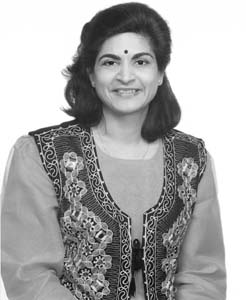![[MetroActive Dining]](/gifs/dining468.gif)
[ Dining Index | Sonoma County | MetroActive Central | Archives ]
Spice Girl
Photo by Olan Mills
Laxmi Hiremath points the way to fresh, light southern Indian cooking
By Marina Wolf
AS WITH MANY an immigrant before her, Laxmi Hiremath found her culinary skills sorely taxed when she arrived in the United States from India with her husband in 1986. Though she had watched her mother in the kitchen from a very early age, Hiremath had always had cooks to do the cooking.
There was only one Indian grocery store near the Hiremaths' first American home in Columbus, Ohio, and the food there was too expensive. So aside from long phone calls to her mother and sister in India, Hiremath was on her own. "I'd go into the supermarket and pick up any vegetable," she recalls of those first confusing years. "I'd take avocado and turn it into curry, or make chutney out of kiwi fruit.
"That's how I started to innovate."
Hiremath's cooking is innovative in other ways as well. She is a prominent advocate of the cuisine of the Indian South, a culinary tradition that has emerged in the United States over only the past decade or two. Its use of rice, seafood, and lighter breads set southern Indian cooking apart from the rich, heavy foods of the landlocked, mountainous north, which up until now have been the staples of Indian restaurant cooking in America. It's this richness that has driven many non-Indians away from either eating or making Indian food, according to Hiremath. "Sometimes when people go to Indian restaurants and they find the food a little heavy and greasy, then they just get turned off and they don't want to try again."
With its emphasis on high flavor and lighter ingredients, southern Indian cooking fits right in with the current American passion for lighter fare. It is also ideal for summer days and hotter climes, as the prominent use of chilis encourages sweating, our body's natural cooling mechanism. And though southern Indian cooking offers an extravaganza of fish-based curries, it is also rich with vegetarian choices--by one count, over 80 percent of the population of India is vegetarian. This predominance has meant that a strong, vibrant vegetarian repertoire is very much part of mainstream Indian cooking, as Hiremath demonstrated in 1995 in her first book, Laxmi's Vegetarian Kitchen.
ANOTHER ASPECT of Indian cooking has been a little more difficult to demystify: spices. The use of spices in Indian cuisine is legendary: spice blends, or masalas, are often passed along from generation to generation like precious heirlooms. Hiremath's mother has developed a 50-spice masala for use at home, which Hiremath has "simplified" to include only 25. But once American cooks learn the basics of selecting and using spices, as Hiremath outlines in her book and in her many classes, they can begin to create their own blends from the spices found in any well-stocked Western grocery store.
Hiremath has further streamlined Indian cooking by simplifying techniques. For example, stuffed bread, a perennial favorite, is a thin piece of dough filled with a precooked vegetable stuffing, sealed, and then rolled flat before griddling, a complicated procedure that Hiremath says is fraught with danger. "With someone who is not an expert, the filling starts to come out; it spills out and just makes a mess on the griddle." Hiremath solved the problem by incorporating seasonings and raw vegetables into the dough itself, using a non-traditional food processor.
Such innovations may shock more traditional Indian cooks, but Hiremath has found that even other Indian immigrants welcome such suggestions. Like their American-born neighbors, they are getting busier, Hiremath says with a shrug and a smile. "Everybody is looking to save time."
[ Sonoma County | MetroActive Central | Archives ]
Copyright © Metro Publishing Inc. Maintained by Boulevards New Media.
![]()
 Southern cooking: Laxmi Hiremath has streamlined her native cuisine.
Southern cooking: Laxmi Hiremath has streamlined her native cuisine.
Laxmi Hiremath will teach "Flavors of Tropical India" at the Santa Rosa Food for Thought on Saturday, June 5. The fee is $30. To register or to receive a catalog of classes, call 575-5363.
From the June 3-9, 1999 issue of the Sonoma County Independent.